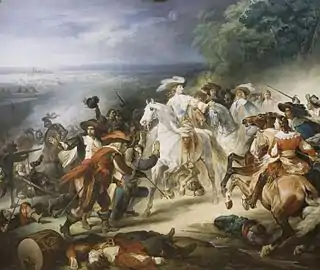François Joseph Heim
François Joseph Heim (16 December 1787 - 29 September 1865) was a French painter.

Biography
He was born at Belfort. He early distinguished himself at the École Centrale of Strassburg, and in 1803 entered the studio of Vincent at Paris. He was a fellow student of Horace Vernet. He won the second place in the 1806 Prix de Rome.[1] In 1807 he obtained the first prize, and in 1812 his picture of "The Arrival of Jacob in Mesapotomia" (Bordeaux Musée des Beaux-Arts)[2] won for him a gold medal of the first class, which he again obtained in 1817, when he exhibited, together with other works, a St John — bought by Vivant Denon. And Jacob appeared again as he submitted Joseph's Coat Brought Back to Jacob to the Salon of 1817.
In 1819 the "Resurrection of Lazarus" (Cathedral Autun), the "Martyrdom of St Cyr" (St Gervais), and two scenes from the life of Vespasian (ordered by the king) attracted attention. In 1823 the "Re-erection of the Royal Tombs at St Denis," the "Martyrdom of St Laurence" (Nôtre Dame) and several full-length portraits increased the painter's popularity; and in 1824, when he exhibited his great canvas, the "Massacre of the Jews" (Louvre), Heim was rewarded with the Legion of Honour.
In 1827 appeared the "King giving away Prizes at the Salon of 1824" (Louvre—engraved by Jazet) the picture by which Heim is best known and "Saint Hyacinthe." Fame arrived with Charles X Rewarding Artists, and he was regarded as the "Bourbons' appointed artist".[4] Heim was now commissioned to decorate the Gallery Charles X (Louvre). Though ridiculed by the romantists, Heim succeeded Regnault at the Institute in 1834, shortly after which he commenced a series of drawings of the celebrities of his day, which are of much interest. Commissions do not dry up during the July Monarchy, though he was criticized for his academicism.
His decorations of the Conference room of the Chamber of Deputies were completed in 1844; and in 1847 his works at the Salon "Champ de Mai" and "Reading a Play at the Théâtre Français" were the signal for violent criticisms. Yet something like a turn of opinion in his favour took place at the exhibition of 1851; his powers as draughtsman and the occasional merits of his composition were recognized, and toleration extended even to his colour. The Second Empire saw Heim's popularity resurrect. He was appointed President of the Académie des Beaux-Arts in 1853 and had a great success at the World Exhibition of 1855 with The Victories of Judas Macabaeus and The Battle of Rocroy.
Heim was awarded the great gold medal, and in 1855—having sent to the Salon no less than sixteen portraits, amongst which may be cited those of Cuvier, Geoffroy de St Hilaire, and Madame Hersent he was made officer of the legion of honour. In 1859 he again exhibited a curious collection of portraits, sixty-four members of the Institute arranged in groups of four. The poet Baudelaire admired his sketches for their, "marvellous understanding of the way humans pull faces".
Besides the paintings already mentioned, there is to be seen in Nôtre Dame de Lorette (Paris) a work executed on the spot; and the museum of Strassburg contains an excellent example of his easel pictures, the subject of which is a Shepherd Drinking from a Spring. He also decorated the Palais Bourbon and the Hotel de Lassay. Jean-Pierre Cuzin, curator of paintings in the Louvre, has called Heim "perhaps the last representative in France of what could be called traditional painting and, as such, somewhat out of place in the middle of the nineteenth century." [5] Baudelaire called him "an eminent, distinguished artist, a searcher who misses being a fine genius by only a millimetre or a milligram of anything."
The writer Jean-Paul Kauffmann, who was himself a prisoner (1983-1988), having been kidnapped while working as a journalist in Lebanon has praised Heim's work and in particular a work of 1840 in the gallery at Semur-en-Auxois called The Prisoner - " The drawing is superb, and the pose conveys the anguish of silent suffering - and the very Caravaggesque sense of light and setting cannot fail to make the viewer curious."[6]
References
- Wrestling with the Angel, Jean-Paul Kauffmann, p.141
- Wrestling with the Angel, Jean-Paul Kauffmann, p.142
- Wrestling with the Angel, Jean-Paul Kauffmann, p.142
- Wrestling with the Angel, Jean-Paul Kauffmann, p.142
- Cuzin, article in Societe de l'histoire de l'art francais, 1992
- Wrestling with the Angel, Jean-Paul Kauffmann, p.142
 This article incorporates text from a publication now in the public domain: Chisholm, Hugh, ed. (1911). "Heim, François Joseph". Encyclopædia Britannica. 13 (11th ed.). Cambridge University Press. p. 213.
This article incorporates text from a publication now in the public domain: Chisholm, Hugh, ed. (1911). "Heim, François Joseph". Encyclopædia Britannica. 13 (11th ed.). Cambridge University Press. p. 213.
| Wikimedia Commons has media related to François-Joseph Heim. |
